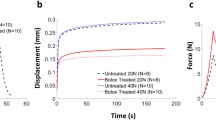Summary
The purpose of this study was to examine the effect of anabolic steroid hormones and exercise training on skeletal tendons. Female mice were exercised for 1 and 10 weeks in an endurance running programme on a treadmill. The altered ultrastructure of tendons caused by simultaneously administered anabolic steroid hormone was investigated by electron microscopy. A stereoscopic analysis of collagen fibrils was performed in order to reveal the changes in the architecture of tendons and to quantify the extent of possible injuries to their functional structure. The occurrence of tendon injuries was detected by the appearance of a collagen dysplasia. The morphometric analysis of the degree of the collagen dysplasia in the different experimental groups reveals that it becomes even more conspicuous in the tendons of the mice which were both exercised and given anabolic steroids. The overall picture and the architecture of the tendons provide tentative evidence that anabolic steroid hormones may induce tendon injuries, depending on the duration of treatment. The direct effect of anabolic steroids on tendons has to be taken into account when considering the clinical disorders of tendons and ligaments which occur in high-class athletes.
Résumé
Le but de ce travail est de juger l'effet sur les tendons des hormones anaboliques stéroïdes et de l'entraînement. Quarante souris femelles ont été entraînées sur un ergomètre pendant une à dix semaines. Par microscopie électronique on a étudié les modifications ultra-structurelles des tendons, induites par des doses simultanées d'hormones anaboliques stéroïdes. Afin de détecter des modifications de l'architecture des tendons et afin de mesurer l'étendue d'altérations éventuelles de leur structure fonctionnelle, on a réalisé une analyse stéréologique des fibrilles collagènes. L'existence de lésions tendineuses a été mise en évidence par l'apparition d'une dysplasie collagène. L'analyse morphométrique du degré de cette dysplasie dans les différents groupes expérimentaux montre qu'elle est particulièrement marquée chez les souris qui étaient soumises à l'entraînement et qui recevaient en même temps des stéroïdes anabolisants. L'aspect et l'architecture des tendons prouvent que les hormones anaboliques stéroïdes peuvent causer des lésions tendineuses, fonction de la durée du traitement. L'effet direct de ces hormones doit être pris en considération en présence de manifestations cliniques au niveau des tendons et des ligaments survenant chez des athlètes de haut niveau.
Similar content being viewed by others
References
Dorfman RJ, Shipley RA (1956) Biochemistry, physiology and clinical significance. Wiley, New York
Fischer N, Staubsand J (1982) Zur Ultrastruktur kollagener Fibrillen in normalen und veränderten Blutgefäßen. Acta Anat 114: 125–145
Hartmann G (1986) Zur Wirkung von Testosteron und Training auf Funktionsstrukturen des vegetativen Nervensystems. Morphologische und biochemische Untersuchungen am Kammermyocard und Nebennierenmark. Strauß, Köln
Michna H (1983) A peculiar myofibrillar pattern in the murine muscle-tendon junction. Cell Tissue Res 233: 227–231
Michna H (1984a) Morphometric analysis of loading-induced changes in collagen fibril populations in young tendons. Cell Tissue Res 236: 465–470
Michna H (1984b) Anabolika und Sportschäden an Sehnen. Richarz, St. Augustin
Olsen BR (1981) Collagen biosynthesis. In: De Hay (ed) Cell biology of extracellular matrix. Plenum Press, New York, pp 139–177
Parry DAD, Craig AS (1977) Quantitative electron microscope observations of the collagen fibrils in rat-tail tendon. Biopolymers 16: 1015–1031
Parry DAD, Craig AS, Barnes GRG (1978) Tendon and ligament from the horse: an ultrastructural study of collagen fibrils and elastic fibres as a function of age. Proc R Soc Lond (Biol) 203: 293–303
Payne AH (1975) Anabolic steroids in athletics. Brit J Sports Med 9: 83
Sachs L (1984) Angewandte Statistik. 5th ed. Springer, Berlin Heidelberg New York Tokyo
Schmiedbusch H, Steel F, Engler K-J (1982) Kollagendys-plasie in der Palmaraponeurose bei Morbus Dupuytren (MD): Eine ultrastrukturelle und morphometrische Studie. Morphol Med 2: 199–206
Staubesand J, Fischer N (1979) Collagen dysplasia and matrix vesicles. Researches with the electron microscope into the problem of so-called “weakness of the vessel wall”. Path Res Pract 165: 374–391
Taylor WN (1982) Anabolic steroids and the athlete. Mc Farland, London
Underwood EE (1970) Qualitative Stereology. Addison-Wesley, New York
Venable JH, Coggeshall R (1965) A simplified lead citrate stain for use in electron microscopy. J Cell Biol 25: 407–408
Weibel ER (1979) Stereological Methods. Vol. 1. Academic Press, London
Author information
Authors and Affiliations
Rights and permissions
About this article
Cite this article
Michna, H. Tendon injuries induced by exercise and anabolic steroids in experimental mice. International Orthopaedics 11, 157–162 (1987). https://doi.org/10.1007/BF00266702
Issue Date:
DOI: https://doi.org/10.1007/BF00266702




